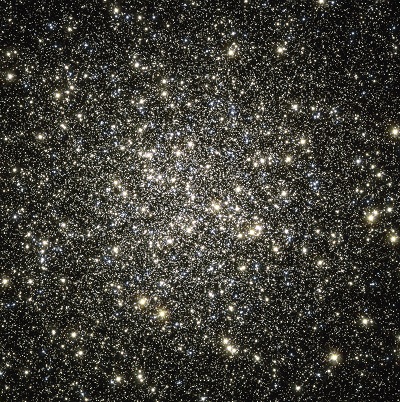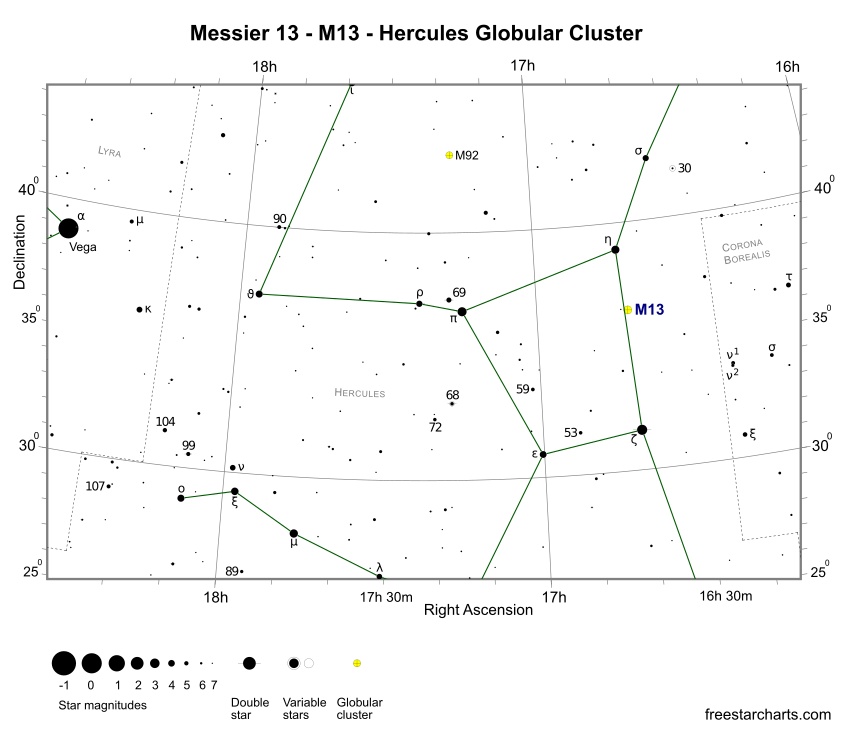M13 is a spectacular globular cluster and the best example of its type in the northern section of sky. It's the standout deep sky object in the constellation of Hercules and is sometimes referred to as the Great Hercules Globular Cluster. At mag. +5.8, it's just about visible to the naked eye and an easy binocular target. The popularity of M13 is mainly due to its declination; it lies at 36N and from northern temperate latitudes is well placed high in the sky during summer months. There are many other globulars larger and brighter than M13, but all are located in the southern section of the sky. As a result, they either never rise or appear low down from most North America, European and Asian locations. Hence, M13 is perhaps the most observed and studied globular cluster of all.
M13 was discovered by the Astronomer Royal, Sir Edmond Halley in 1714. He described it as "a little patch, but shews itself to the naked eye, when the sky is serene and the Moon is absent". Fifty years later, Charles Messier catalogued it on June 1, 1764.


Finder Chart for M13 - pdf format (credit:- freestarcharts)
The globular is easily found on the western side of the Hercules "Keystone" asterism, 2.5 degrees south of Eta Herculis (η Her) and along a line connecting Eta Herculis (η Her) with Zeta Herculis (ζ Her). When viewed through 10x50 binoculars, it appears as bright fuzzy ball with a well-defined center that's obviously non-stellar but without resolution. The cluster forms a right angled triangle with two nearby 7th magnitude stars. An 80 mm (3.1-inch) telescope shows M13 as a uniform extended hazy disk about 8 arc minutes across. At magnifications of about 100x, it looks like a zoomed in version of the binocular view. A 100mm (4-inch) telescope will resolve some of the outer stars, with many more visible in 150mm (6-inch) and 200mm (8-inch) instruments. The brightest star in M13 is variable star V11 (apparent mag. +11.95).
In large amateur telescopes, M13 is truly sensational sight with the complete field awash with stars. When viewed through a 250mm (10-inch) scope, hundreds of stars are visible against the dark background sky. The cluster appears 3-dimensional and breathtaking. In total, it has an apparent size of about 20 arc minutes though visually it appears smaller, perhaps 12-13 arc minutes across. There are a couple of curious affects visible at a high magnification. Many of the outer stars seem to be arranged in long arcs, weaving their way across the cluster face and the distribution of the bright stars across the surface is not even. This can result in an optical illusion of apparent voids or relatively barren areas interspersed across the cluster. Also visible at medium/high magnifications in telescopes of the order of 300mm (12-inch) are three dark dust lanes that form a Y shape towards the southeast of the core. This is known as the "propeller" and was first noticed by Bindon Stoney in the 1850s from Birr Castle in Ireland using the 72-inch reflector, the largest telescope in the World at the time.
The globular is located 25,100 light-years from Earth. It has a spatial diameter of 145 light-years and is estimated to contain about 300,000 stars. M13 appears big and bright due to its close proximity, not because it's intrinsically luminous or large. In 1974, it was chosen as the target for the Arecibo radio message. This was designed to communicate the existence of human life to hypothetical extraterrestrials that may live on a planet orbiting one of the thousands of stars in M13. The test was more of a technological demonstration than a realistic communications effort. Since the signal will take 25,100 years to arrive, M13 will have moved position and no longer be in the correct location to receive it.
M13 Data Table
| Messier | 13 |
|---|---|
| NGC | 6205 |
| Name | Great Hercules Globular Cluster |
| Object Type | Globular Cluster |
| Constellation | Hercules |
| Distance (light-years) | 25,100 |
| Apparent Mag. | +5.8 |
| RA (J2000) | 16h 41m 41s |
| DEC (J2000) | +36d 27m 41s |
| Apparent Size (arc mins) | 20 x 20 |
| Radius (light-years) | 72.5 |
| Age (years) | 11.65 Billion |
| Number of Stars | 300,000 |